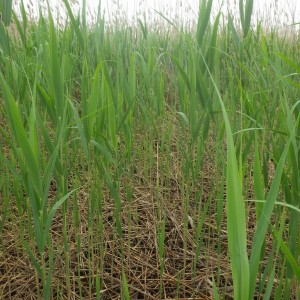by Chris Haight
June 2013
Invasive species management can be a tricky endeavor, especially when you are dealing with such a pugnacious species as Phragmites australis. Invasive management seems like it has a straightforward approach; you have a problem – the invasive species – and the solution is to get rid of it. But, whenever you are dealing with any organism, it must be recognized that it is just one piece of a large ecosystem that is comprised of an intricate network of participants, processes, and their interactions. The simple addition or removal of one piece can change the workings of the whole system. Management efforts need to be based on the understanding of the ecosystem as a whole, which means there needs to be an understanding not only of the invasive species, but also the role of that species in the greater ecosystem. In addition, the feasibility of the restoration project needs to be assessed by understanding the ability of the native state of the system (species, processes, and interactions) to return after the eradication of the invasive species. Without this knowledge the management goals may not be achieved and the system could remain invaded or even further impacted.
The Case of the Common Reed:
Phragmites australis is a clonal wetland plant species, meaning that a single plant is made up of many clones or nodes connected by an underground structure called a rhizome. It can be found in both marine and freshwater environments. In the North America, there is a native form, which has been around for thousands of years, and there is an invasive form, which has only been around for just under 200 years. These plants form dense colonies in wetlands that they invade by seed or rhizome establishment and vegetative growth. They expand underground through their rhizomes and move across the wetlands, outcompeting the other plant species for nutrients, space, and sunlight. Some researchers believe that Phragmites is highly invasive because it has the competitive advantage of allelopathy, or chemical toxins released through their roots, that inhibit the growth of competing species. Today, many coastal wetlands in marine habitats, such as the Atlantic coast, as well as inland freshwater wetlands, such as those on the Great Lakes and along the Mississippi River, are dominated by Phragmites. It is a major management issue, but before remediation plans are made, Phragmites needs to be examined in the context of the ecosystem that it inhabits.
Phragmites australis affects wetland ecosystems in several ways. It reduces the biodiversity by ousting many plant and animal species that have been long standing players in the ecosystem. The loss in biodiversity is also partially driven by changes in the physical structure of the marsh including increased rates of sedimentation and plant litter build up. This reduces flooding frequency, from tidal or storm surges, and, along with the high stem densities, reduces the ability of fish, birds, and other wildlife to forage on the bountiful wetland surface. However, in marine coastal areas, the heightened elevation of the marsh and its faster rise keep it from the watery grasp of sea level rise, which threatens many coastal environments. In freshwater areas, the deep and dense root structure of the invasive plant make the wetland very stable, preventing erosion due to wave action from boats or storms. Phragmites also is excellent at absorbing nutrients from the peat, which is a vital service, as excess nutrient runoff can be very detrimental to freshwater and marine systems. The point is that a Phragmites dominated wetland is not without value and it should be treated as a functioning ecosystem, especially when planning a remediation project.
Management action needs to take an ecosystem approach to restoration and examine the system in its current and, if possible, pre-invaded state. This will provide a baseline that can be used as a reference point when evaluating the success of the restoration project. It will also reveal what needs to be improved and preserved in the ecosystem as part of the remediation efforts. There should also be careful consideration for the eradication methods used, as most Phragmites remediation projects use harmful herbicides for removal, while there are more natural methods such as burning, flooding, or livestock grazing. It should also be understood that Phragmites eradication is not a one-season endeavor; it is more of a Phragmites curtailing coupled with long-term maintenance to keep it at bay. Most importantly, the restorability of the system needs to be determined. Research needs to be conducted prior to remediation action to determine the presence of a native seed bank and the ability of that seed bank to yield native plant growth after the removal of Phragmites. Invasive Phragmites is a fickle plant that has claimed its stake in many wetlands in the North America. In order to return these systems to a state reminiscent of their native past, management needs to look beyond invasive species to the ecosystem and the role that species plays in that system. Such an approach will allow for the restoration of the whole ecosystem instead of just dealing with one small piece.

